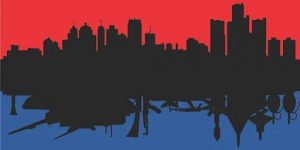
Illustration by Amanda Matyas
Israel has been called “not a country with an army, but an army with a country.” The proliferation of military equipment, tactics and culture into the Detroit Police Department (DPD) suggests that we could soon define our city in similar terms: as a police department with a city, not a city with a police department.
What is police militarization?
Police militarization takes two distinct forms: “direct militarization,” the use of federal military forces for civilian policing, and “indirect militarization,” civilian police forces acting like federal military forces, using a combination of equipment, tactics and practicing a culture designed for warfare. The creation of the Department of Homeland Security in 2002 blurred the lines between Federal domestic law enforcement and what we think of as traditional military forces. In understanding the militarization of state and local police departments, all Federal troops, whether nominally civilian like the FBI or overtly military like the US Army should be considered as forms of direct militarization.
A brief history of police militarization in Detroit
Militarization is not new to the Detroit Police Department (DPD). Activist Ron Scott, in an interview for Eyes on the Prize, defined the Big Four, a team of four DPD officers who rode around harassing and beating people, predominantly black people, on the street in 1960s Detroit, as “an army of occupation.” During the 1967 Rebellion, the National Guard and the 101st Airborne Division of the US Army were called in to suppress the people.
Four years later, on January 13, 1971, a new policing project, STRESS (Stop the Robberies, Enjoy Safe Streets) was inaugurated by Police Commissioner, John Nichols. According to From the Ground Up’s 1973 report Detroit Under STRESS, “Another feature of [STRESS] which is cause for concern is the militarization of local police. Ample evidence is available documenting the utilization in the domestic law enforcement scene of new terminology, operating techniques, weaponry, and equipment produced from the field tests of counterinsurgency activity abroad.”
While STRESS was supposedly focused on robberies, it is perhaps no coincidence that it was founded in the same year President Nixon formally announced the War on Drugs and the creation of the Office of Drug Abuse Law Enforcement (ODALE). ODALE, like STRESS, unleashed police “commandos” with military equipment into poor, working class, predominantly black neighborhoods. Victims of both programs reported having their doors kicked in through the use of no-knock warrants, being held at gunpoint and they are cited as being directly responsible for the wanton murder of civilians in the pursuit of criminal activity.
STRESS was disbanded in 1974, but the War on Drugs continued. Successive policies of the Reagan and G. H. W. Bush administrations throughout the 1980s increased direct and indirect militarization in cities across the U.S., culminating with the 1990 National Defense Authorization Act (NDAA). NDAA Section 1208, (replaced in 1996 with Section 1033) authorized the transfer of “surplus” Department of Defense property, deemed suitable for use in the War on Drugs, to state and local police. This program is known today as the 1033 program.
In the wake of 9/11, the War on Drugs was superseded by the War on Terror. The newly created Department of Homeland Security (DHS) began providing funding to police departments to build arsenals “just in case” of a terrorist attack in their jurisdictions. The DHS complemented the 1033 program, which found a new source of “surplus” equipment from the wars in Afghanistan and Iraq, with funding, $34 billion between 2002 and 2016, for police departments to buy military equipment directly from corporations such as Lockheed Martin.
Direct militarization of DPD
In December 2019, DPD signed on to Operation Relentless Pursuit. According to the Department of Justice the program “involves increasing the number of federal law enforcement in selected cities.” In Detroit that meant 10 new US Marshal Task Force Officers, 7 new DEA personnel and $3.9 million in grants to Detroit and Wayne County. In August 2020, DPD doubled down on its commitment to bringing Federal troops into the city through Operation Legend, adding a further 44 agents from the Bureau of Alcohol, Tobacco and Firearms, 12 FBI agents and $1.4 million in funding including $100K for Shotspotter acoustic gunshot detection technology.
Additional Federal troops in Detroit include at least 421 Customs and Border Patrol (CBP) agents. In 2020 additional Border Patrol Tactical Unit (BORTAC) agents were deployed to the city in response to requests for assistance from Immigration and Customs Enforcement (ICE). BORTAC “acts essentially as the SWAT team of the Border Patrol. With additional gear such as stun grenades and enhanced Special Forces-type training, including sniper certification.” Despite Michigan’s ranking 16th of all US States in the size of its undocumented population, it ranked 2nd in number of “community arrests” between 2017 and 2018, behind only Pennsylvania. “Community arrests” occur when “ICE arrests individuals it believes are deportable after it finds or encounters them out in the community.”
Indirect militarization of DPD
The largest purveyor of military equipment to US police departments is the Pentagon. As of 2016, the 1033 program has transferred more than $5.4 billion in military equipment from DoD to police departments in all 50 states. Between 2014, the first year DoD was required to provide itemized lists of 1033 program transfers to specific police departments, and in 2020 DPD received $2.3 million worth of equipment. Acquisitions include 2 Observation Helicopters, 76 Thermal and Reflex Sights, and 4 Packbot 510 robots. The Packbot 510 is “designed for use by troops and first responders to carry out dangerous missions in high-threat battlefield scenarios.”
Much of the equipment received through the 1033 program goes to Special Weapons and Tactics (SWAT) teams. Detroit’s SWAT team is called the Special Response Team (SRT). Military tactics are clearly on display in the deployment of SWAT/SRT. Officers receive advanced combat training, teams are modeled on a military command structure, and are committed to using militarized equipment, including battering rams, grenades, combat helmets, and armored personnel carriers. Far from their originally stated mission to deal with hostage or barricade situations, research by the American Civil Liberties Union (ACLU) found that 79% of SWAT deployments are to execute search warrants, of these 54% were deployments against minorities and 65% involved forced entry using a breaching device.
The police officers joining SWAT/SRT and using this equipment are increasingly likely to be veterans returning from the wars in Afghanistan and Iraq. Despite making up only 8% of the general population, roughly 22% of police officers are veterans. Since 9/11 successive administrations have incentivized the hiring of veterans by requiring that hiring grant funds be used to hire only or predominantly veterans. This has resulted in a force of officers who “come back to Baltimore, Camden or Detroit and functions (sic) the same way we did when occupying Kabul or Baghdad,” according to veteran Daniel Sjursen. In 2020, Detroit received nearly $2.5 million to hire 15 new officers through the Federal Cops Hiring Program. The DPD’s application for this funding states that it “will use these funds to hire 15 officers [including at least one military veteran] in support of Operation Relentless Pursuit.”
Militarization and communities
The proliferation of Federal agents, military equipment, tactics, and culture in DPD creates an environment where officers see themselves as warriors and members of the public as either enemies to be vaporized or innocents to be protected. In addition, staging interactions between police, in heavily militarized riot gear, and protestors; between SWAT/SRT officers, in combat dress and carrying M16s, and suspects, as if they were on a battlefield, habituates both officers and civilians to a militarized environment in Detroit.
While militarization motivates police officers and makes them feel safer, it has the opposite effect on the public. Militarization results in public perception of increased levels of crime, feeling less safe, not wanting police in your neighborhood, and reduced support for increasing police funding.
Some of these public responses can be understood by studying the “Weapons Effect,” the theory that the mere presence of weapons promotes more aggressive and violent behavior. As social psychologist Bruce Bartholow told The Cut, “the more you fill the environment with stimuli that are associated with violence, the more likely violence is to occur.”
Militarization has been a part of DPD for more than 50 years. Many reformists argue that the weapons, tactics, and culture of militarization are not the problem, and that what is needed is retraining. But retraining of whom, for what? Of veterans to police, of police to counselors, or of the citizens and city of Detroit to become a police department with a city?
This article originally appeared in September 2020 as part of a series of articles about policing and its alternatives in The Detroit Socialist. Sadly, the only thing that has changed is an increase in the number of veterans on our police forces. Four years later it still feels as relevant today as it did then.


